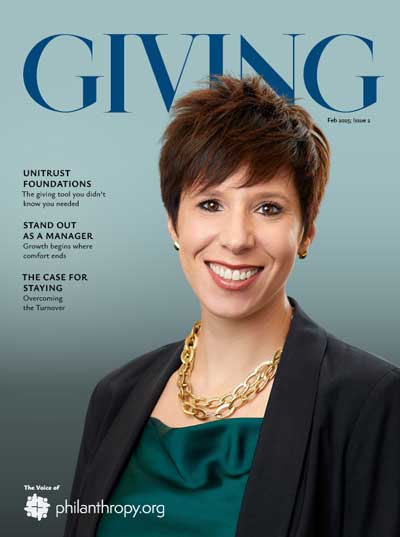DAFs are where generosity sometimes goes to nap—but also where smart giving starts. With over $160 billion waiting in the wings, Donor-Advised Funds can sometimes walk the line between philanthropic foresight and … procrastination. Wrapped in tax advantages, moral applause, and just enough paperwork to feel busy, they’re the velvet rope section of charitable giving. Whether you’re funding climate activism, the NRA, or a dog yoga retreat in Boulder, DAFs let you hit pause on impact—while still collecting your halo points.
This satirical exposé unpacks how DAFs can be used to stall—but also why they remain one of the most strategic tools in modern philanthropy.
Welcome to the Spin Cycle
There’s brilliance in DAFs. They allow donors to be strategic rather than impulsive.
Step right up to philanthropy’s favorite appliance: the Donor-Advised Fund. It’s the only machine where you can toss in a bundle of appreciated assets, shrink your tax burden like a wool sweater on high heat, and emerge with your halo gleaming—while your dollars remain comfortably parked.
Think of it as the magic sock drawer of charitable giving: money goes in, good intentions are declared, and the actual impact? Well … that part can wait. Maybe next year. Or the year after.
To be fair, there’s brilliance in the design. DAFs allow donors to be strategic rather than impulsive. They create a flexible, tax-efficient way to earmark funds for future generosity—especially when donors need time to plan or coordinate complex gifts. In the right hands, they can be a powerful engine for long-term impact.
But when does strategic giving become indefinite deferral? Where do we draw the line regarding donor advised fund accountability?
How It Works (or Doesn’t, Depending on Who’s Asking)
Imagine a system that lets you:
- Claim a tax deduction today for a gift you might give tomorrow. Or next year. Or when your grandkids remember the password to your Fidelity Charitable account.
- Keep your name out of the papers if you’re funding a climate justice collective that prints anti-capitalist slogans on imported organic hoodies. Prefer public praise and naming rights on a building? That’s available too.
- Advise on where the money goes (eventually), but never actually have to send it anywhere.
It’s like a savings account for your conscience—with better PR.
Imagine a system where you get the applause of giving—before the gift actually lands.
DAFs: Doing Altruism Flexibly
Subsidize Greta’s jet. Fund the NRA. Support a dog yoga retreat. Anything is possible—except urgency.”
The beauty of DAFs is their flexibility. You can support the arts, fight climate change, fund the NRA, or sponsor a dog yoga retreat in Boulder, Colorado, complete with chakra-balancing chew toys and vegan fire hydrants.
Or, if you’re feeling really transcendent, subsidize Greta’s next coast-to-coast jet tour to lecture the rest of us about carbon emissions—burning enough energy to produce 2.6 million plastic bottles (yes, we did the math)—just to give a TED Talk on sustainability at a donor gala handing out recyclable virtue in compostable envelopes, hosted by billionaires who fly private but tweet about equity. Phew!
Because nothing says “impact” like offsetting your carbon footprint with a branded tote bag woven from Himalayan hemp and self-righteousness.
The Math of Virtue
You did the Greta math—now let’s do this one:
- $250 billion+ sits in DAFs.
- Less than 25% is distributed annually.
- That’s over $200 billion just hanging out, relaxing, compounding, and waiting for the donor to finish their soul-searching journey.
If you’re a starving nonprofit, just remember: Donors are on their own timeline. Be patient. Good things come to those who wait. And wait. And wait …
However, also remember that the average payout rate for DAFs is over 23%—far above the 5% minimum for private foundations.
Average payout rate for DAFs is over 23%—far above the 5% minimum for private foundations
Who Needs Transparency Anyway?
DAFs are the perfect tool for the image-conscious donor. You can:
- Avoid public scrutiny.
- Bypass pesky journalists.
- Skip explaining why your foundation gave $1 million to “Friends of Tax Reform and Trout Conservation.”
It’s clean. It’s efficient. It’s … legally opaque.
You see, when it comes to donor advised fund accountability, DAFs are regulated—just not in a way that creates urgency, accountability, or meaningful oversight. Which is why some call them “philanthropy’s legal laundromats.”
Not because donors are criminals (they’re not)—but because, like a certain well-dressed crowd from New Jersey, the system allows them to move money, avoid questions, and keep everything technically above board.
It’s not illegal. It’s just high-society laundering—with a tax deduction and a catered luncheon.
But Wait—It Gets Better!
Your DAF can even become a family tradition.
Why let your children inherit only your wealth when you can also pass down your vague charitable intentions? That’s legacy planning—with optional follow-through.
And with just a little foresight, your great-grandchildren might one day “advise” a grant to install a park bench … named after you.
That’s impact. Eventually.
DAFs Work. Let’s Make Them Work Better.
Donor-Advised Funds are among the most powerful and flexible tools in modern philanthropy. They allow donors to give strategically, respond to urgent needs, and plan thoughtfully across generations. When used well, DAFs unlock generosity that might otherwise stay trapped in bureaucracy, hesitation, or indecision.
But like any tool, their strength lies in how they’re used. When DAFs are allowed to sit idle—obscured by silence, stretched across decades, or used as reputational buffers—they risk becoming vehicles of inertia rather than impact.
Donor-Advised Funds are a powerful tool—and with just a little more transparency and urgency, they can be even more powerful.
That means:
- Encouraging thoughtful but timely disbursements
- Promoting transparency that builds public trust
- Ensuring charitable dollars reach the ground where they’re needed most
Because real philanthropy isn’t about parking generosity—it’s about moving it.
And the more DAFs are seen as engines for action rather than storage units, the more they’ll earn not just tax deductions, but genuine admiration.
Philanthropy isn’t defined by intent, but by impact—and deferred giving can be the velvet waiting room of generosity.






